THE CHOIR TRAINERS TOOLKIT
Background Reading
Transposition
To make full use of this page, it's best to be confident with CLEFS, KEYS & KEY SIGNATURES and INTERVALS.
Here is an example (example 1) we want to transpose down 2 steps (a 3rd) [Why is 2 steps a 3rd? See HERE]:
 It's got no sharps or flats as a key signature, so it could be C major or A minor, but the last bass note is C, so it's C major. Down a 3rd gives us A major or Ab major, and we shall choose the latter.
[Brush up your key signatures HERE.]
It's got no sharps or flats as a key signature, so it could be C major or A minor, but the last bass note is C, so it's C major. Down a 3rd gives us A major or Ab major, and we shall choose the latter.
[Brush up your key signatures HERE.]
Write out the new key signature and move all notes down 2 steps - a 3rd, starting like this:
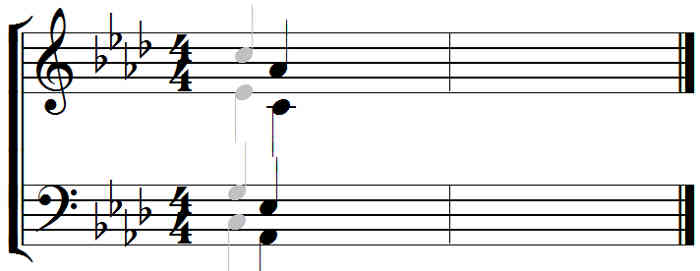 Carry on like this until complete,
Carry on like this until complete,
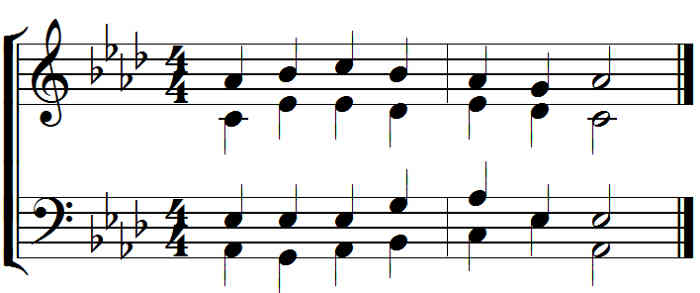 and the job is done.
and the job is done.
This example (example 2) is more complicated as there are accidentals applied to some notes.
We are going to transpose this up one step, a 2nd, to F minor.
Click here to pin example 2 to the top of the page so that it remains visible during scrolling.
Firstly, follow exactly the same process as with the first example, ignoring the accidentals:
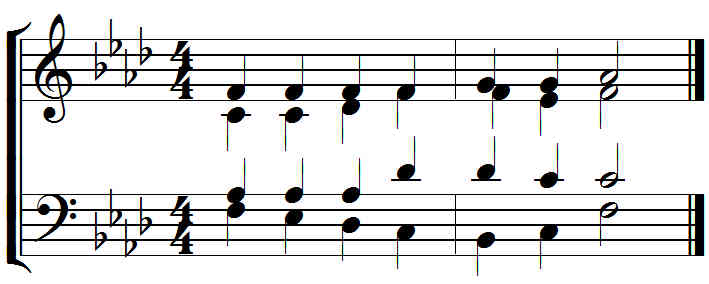 In the original E minor version, each of the sharps 1, 2, 3, and 4, raises their note by one semitone. In the context of the F minor version, the same effect is produced by using natural signs.
In the original E minor version, each of the sharps 1, 2, 3, and 4, raises their note by one semitone. In the context of the F minor version, the same effect is produced by using natural signs.
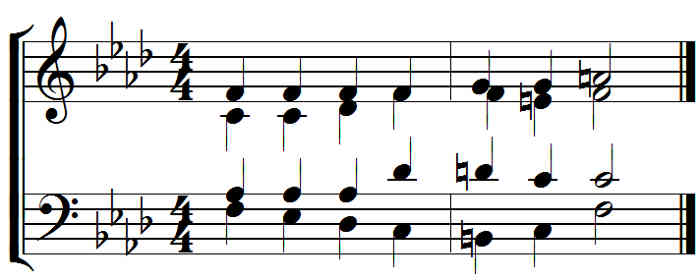
Click here to unpin example 2 from the top of the page.
(It's best to unpin any one example before proceeding. This prevents strange overlappings.)
Here is a much more complex example (example3). The original key is A major, but there is a clutch of awkward accidentals.
Click here to pin example 3 to the top of the page so that is remains visible during scrolling.
We are going to transpose this down to Db major (4 steps - a 5th). As before, we just move all the notes down a 5th:
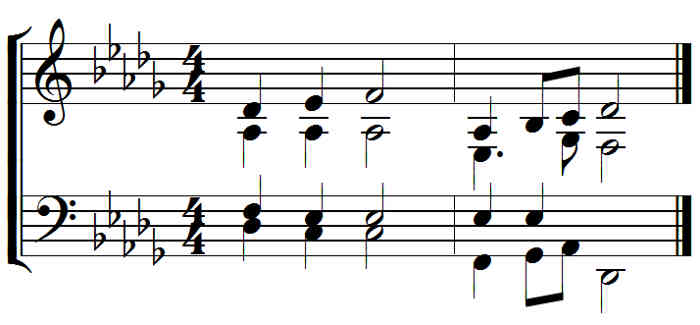 Now we have to think very carefully what each accidental does in the original, and produce exactly the same effect in the new
version, allowing for the new key signature. Having got all the notes in place on the lines and spaces WE USE ACCIDENTALS
TO MAKE THE FINAL ADJUSTMENTS. WE DO NOT, AT THIS STAGE, CHANGE THE LINES AND SPACES.**
Now we have to think very carefully what each accidental does in the original, and produce exactly the same effect in the new
version, allowing for the new key signature. Having got all the notes in place on the lines and spaces WE USE ACCIDENTALS
TO MAKE THE FINAL ADJUSTMENTS. WE DO NOT, AT THIS STAGE, CHANGE THE LINES AND SPACES.**
- In A, 1 lowers the C# a semitone. In Db, the note is F natural, so we lower it to Fb.
- In A, 2 lowers the B a semitone. In Db, the note is already Eb, so we lower it a semitone with a double flat.
- In A, 3 lowers the G# a semitone to G natural. In Db, the note is lowered a semitone from C to C flat.
- In A, 4 raises E a semitone to E#. In Db, the Ab is raised a semitone to A natural.
- In A, 5 raises C# a semitone to C double sharp. In Db, the F is raised a semitone to F#.
- in A, 6 raises D a semitone to D#. In Db, the equivalent note is raised a semitone by a natural.
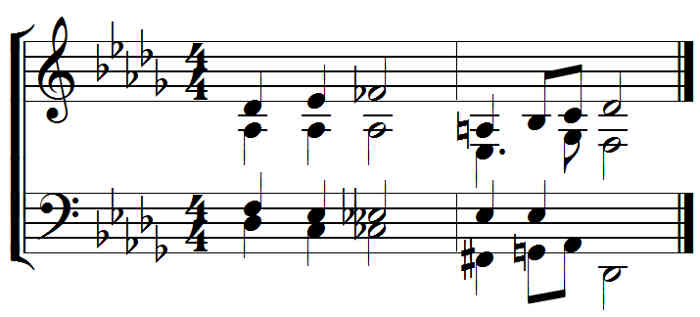
Click here to unpin example 3 from the top of the page.
** Music has its own rules, grammar and logic. Although, for instance, the notes Fb and E are the same on a piano, and it may seem quicker or simpler to write E, these rules sometimes demand an Fb. It's a
bit like writing school, not skool, or rough not ruff. More about this HERE, if you are interested.
RETURN TO:
TOP
MENU - Choir Trainer's Toolkit
MENU - Organists Online
Test Yourself
For these tests, you are going to need a pencil and some manuscript paper. On the off chance that you forgot to pick up a pad of manuscript paper last time you were at the supermarket,
HERE is a printable sheet with the clefs and barlines already added for you.
Test 1
Transpose this snippet:
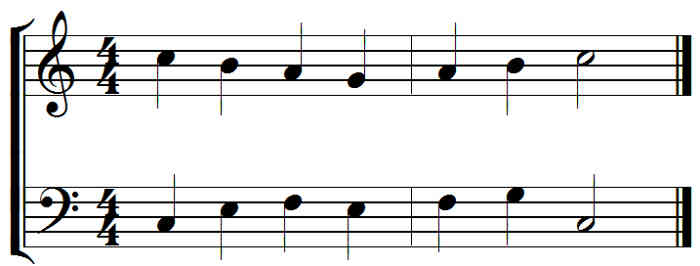 up a step [a 2nd] into D major:
up a step [a 2nd] into D major:
Click here for the answer
and down two steps [a 3rd] into Ab major.
Click here for the answer
Test 2
This example is a little more complex as it introduces accidentals.
Click here to pin the Test 2 to the top of the page so that is remains visible during scrolling.
Transpose it up to Eb major.
Click here for the answer
Click here for an explanation
Transpose it down to C major
Click here for the answer
Click here for an explanation
Click here to unpin Test 2 from the top of the page.
Test 3
Here is a third test:
Click here to pin the Test 3 to the top of the page so that is remains visible during scrolling.
Transpose it down to G major.
Click here for the answer
Click here for an explanation
Transpose it down to F# major. It's not likely that you would ever want to use this key as F major would be so much more convenient.
However, this is an exercise in transposing from a flat key signature to a sharp key signature.
Click here for the answer
Click here for an explanation
Click here to unpin Test 3 from the top of the page.
RETURN TO:
TOP
MENU - Choir Trainer's Toolkit
MENU - Organists Online